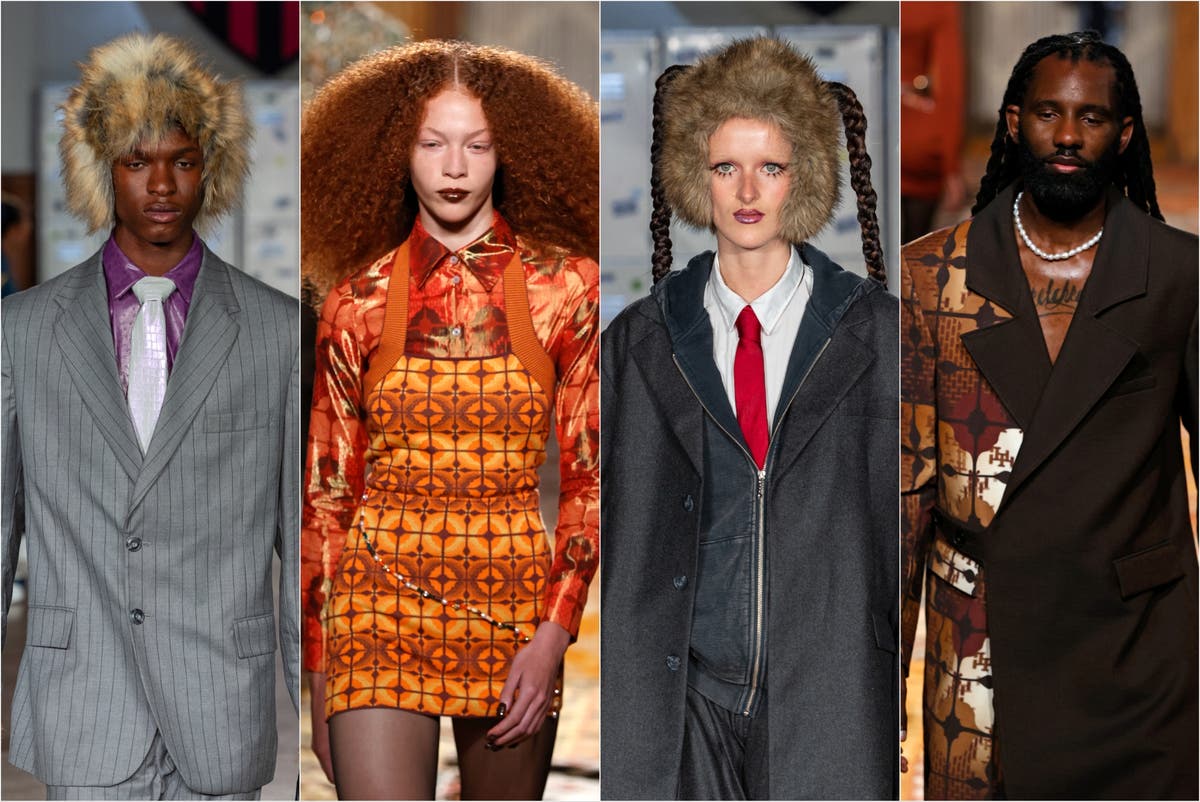Fashion
At London Fashion Week, informal formality is taking the city by storm

It’s been a funny few years for fashion when it comes to trends, or lack thereof. Indeed, aside from the relentless coining and killing of micro-fads (*insert the next -core, girl summer or post-Brat marketing ploy), there’s been no real, let alone enduring, vibe shift on the runways. In London especially, a melting pot of reference points and broader disenchantment with the old selling protocols has paved the way for a hyper-varied offering. This season at London Fashion Week, for the first time since “streetwear” (shudders) was the word on every editor’s lips, an actual, real-life tendency has appeared – one that could be plotted with graphable data instead of dubious TikTok content.
Yes, the kids are suiting and scrubbing up, albeit on their own terms. Leaning into the old trades of tailoring and ladies’ occasion wear, London’s designers have been revamping the increasingly redundant and outdated modes of dressing with DIY inflections, diasporic nuances or, quite simply, mind-blowing material innovation. Why this informal formality has taken the city by storm, it’s hard to say.
Arguably, it’s indicative of a broader, cultural turn. Gone are the days when young people – whether in blue-collar, white-collar or Society milieus – would clock off and slip into their casuals or glad rags, hailing a cab after laborious hours in front of the mirror getting tarted up. Now, you shut the laptop or leave the site, drop your pals a podcast-worthy voicenote and hop on a Lime bike straight to the club.
Certainly, this sense of transience was felt over at the sophomore show of Newgen recipient Luke Derrick, who heads up the eponymous Derrick label. Serving up luminescent suiting in hardy, specially developed nylons, Derrick merged tracksuit construction with Savile Row finesse. Crotches were cut to perfection, while glossy petroleum-hued and koi-orange blazers changed colour under the spotlights.
From the bleachers, the garments felt impressive – as if worked and wrought to their final states. However, the reality came from something simpler, relying on the natural hang of materials and impossibly precise tailoring gleaned from working on the Row and at old-school stalwarts such as Brioni.
“I love the idea that people think these jackets – as people started to last season – have a lot more structure in them than they do,” the designer explained. “People see these garments up close and they’re just shells, which is such a fun trick people encounter when they see it.”
No doubt, the ears of fashion e-com copywriters are ringing. All those copy cliches of “day-to-night wardrobes” and “desk-to-disco ensembles” have finally realised themselves in a way that is neither gimmicky nor unconvincing. Derrick’s clothes felt honestly attuned to our time, ideal for the young creative who works in sweatpants and has a wedding in their diary they can’t quite find a look for.
A similar philosophy was seen in London-born designer Priya Ahluwalia’s rather cocktail-coded collection, which, rather than going heavy on the usual tux and gown, offered a more roomy and honest portrayal of her namesake brand Ahluwalia. Here, flocked viscose sweaters were lined with intricate, glistening beads that clanked and swung across the torso in a nod to her Nigerian heritage.
“I was thinking about how when you’re at home, you’re literally cosy,” said the designer backstage. “In lots of Nigerian homes, there are these door dividers that are beaded curtains, and I just love them in homes. The sound of them gives me a lot of memories.”
Ahluwalia also, in a new growing womenswear enterprise, leant into dressmaking, lining iridescent strappy, panelled numbers with leaf prints pulled from her grandparents’ first home in England. Such sentimental and biographic gestures made the otherwise more austere silhouette feel resolutely hers.
Elsewhere, Skepta’s newly revived label, Mains, took tailoring down a preppy, sometimes collegiate route, treating school uniforms and the more aspirational outfits he had seen growing up with a playful flourish.

Nodding to his school days, ivory suits were printed with compass sets, Kickers shoes were lined with faux-fur trims, and ties arrived with “off-key” Moschino Jeans and Iceberg History-redolent prints, a suspected nod to UK garage that was quickly confirmed when the IYKYK icon, MC Bushkin, descended on the runway in an icy two-piece, setting the Frow – think Dave, Headie One, Chip – into a frenzy of jubilation.
Similarly, this full-circle moment where luxury and “looking smart” become something else, according to a new gen, was felt a few hours before at Aaron Esh’s standout collection. Marking his third runway show, the outing saw wasp-waisted smoking jackets in liquid velvets, teamed with indie-kid leather skinnies that swim across the catwalk.
All the while, gossamer silks with eloquently cowled and ruched necklines kept the offering casual. Satin strips that brought to mind cummerbunds and lapels were woven throughout the looks, but a subtractive approach to styling meant every piece and item counted. Even the more gritty separates felt resolutely demure, arriving in pleated-front denims and harrington jackets, washed out to achieve a shade akin to wet concrete.
Heck, even Sinead Gorey, the south London party princess, served her rendition of event dressing by riffing on the theme of British school proms. Naturally, she ditched the traditional satin frock, going all out with make-believe corset prints and spiked piercing-lined micro-skirts, an essential for any bad girl leaving school with a bang.
“I feel that as I’m developing my own style, it reflects within my designs and aesthetic of the brand,” said Gorey of her new, luxury-tinged predilection. “I’m 27 now, so not wearing the same things I would when I was 21. I find myself looking for evening wear that’s still fun, punky and contemporary, but struggle to find pieces that I love (that don’t cost the world), so I wanted to create my own!”
With 16Arlington, it was business as usual. Marco Capaldo, who co-founded the label with the late designer Federica Cavenati, continued his experiments in mind-boggling pattern-cutting, now several years into running one of London’s chicest (like, actually) labels in the metropolis. Sheer midis sliced down the middle arrived with fine frosted-tip ochre feathers and diamantes or ribbon-back fastening, while one dress appeared like a hybrid between an oversized T-shirt and dress – no clear armholes, just a natural, swaddling drape.
Still, despite being unquestionably elegant, there was a piquant edge to the looks in the show, be it python heels or a pewter lily cuff. Respectfully, it’s the likes of 16Arlington that have been leading the charge for “lady” with an edge and now the look is getting its dues. “I always try and extract the beauty in the slightly more dark, but I think this season more than ever I really wanted to externalise that,” said Capaldo backstage. Across the set, confetti covered the runway. “I think it’s about how our brand has grown, how our woman has grown.”
It was perhaps during JW Anderson and Simone Rocha’s collections that the two extremes of this trend – yes, trend – came to light. For the former, leather slips that almost seamlessly moved from strap to tutu were apt for an invite-only art fair afterparty, where it’s increasingly apparent that the youth are holding court as much as gouty collectors.
For the latter, the soft, dainty and (sorry!) cutesy puffball dresses that pulsated like jellyfish spoke of a softer, still up-for-it type party girl. Or boy, might we add: the tulle flowered bloomer-toting lads will attest, luxury is no longer for the oldies stuck in their ways, but a whole generation of youngsters wanting to pull a look, dressing up to get down regardless of status or class. Long live newer, new luxury.










